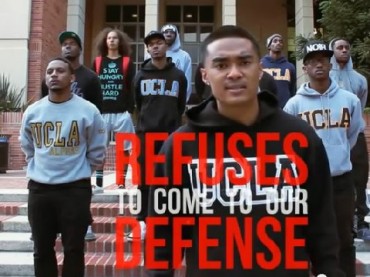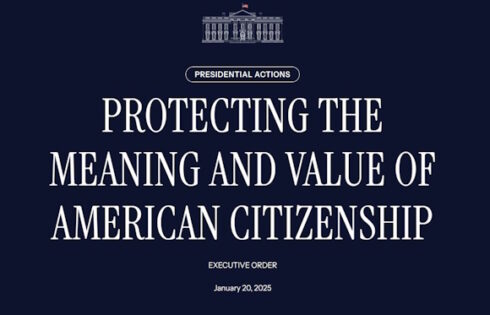
OPINION: It is important to meet such misguided opinions head-on and challenge them on the merits of their arguments. The fact is UCLA does much for diversity already and is a very diverse school.
Back in November, UCLA undergraduate Sy Stokes, a third year Afro-American Studies major, produced the following video. Since then, it’s been viewed nearly 1.8 million times.
The video is prefaced by a slide reminding or enlightening us of the assassination of two black students on the UCLA campus in 1969. It then jumps to black students standing in a group lodging their grievances openly on campus, behind their head spokesman, Stokes, who is currently working on a degree offered by an Afro-American Studies program that may soon become its own independent department at UCLA.
The video implies that current black students are as equally oppressed as black students on campus in 1969. Yet the video’s creator studies in a department wholly devoted to the study of black culture. Of course, only a thoroughly racist institution like UCLA would bother to offer Afro-American Studies as a major.
Judging from the anger in Stokes’s voice and in his peers’ demeanor (at the end of the video the group dramatically takes off their UCLA sweatshirts and drops them to the ground), one might think students and administrators maliciously and intentionally try to thwart black students’ attempts to be successful. That black students face brutality and brick walls everywhere they turn.
Alas, Stokes’s grievance is against something just a tad more tame than physical abuse: he claims black students are “underrepresented,” “marginalized,” and graduating at relatively low rates.
However, in reality, different groups of people are simply represented unequally in different endeavors. It’s what happens in a diverse society where people are free to pursue their own goals. Professional sports, such as basketball and baseball, provide illustrative examples of this.
The racial makeup of the NBA last year was: 76.3 percent black, 0.2 percent Asian, 4.4 percent Latino, and 19 percent white (funny enough, The Institute for Diversity and Ethics and Sport, which produced these statistics in its annual “diversity report card,” gave the overwhelmingly black NBA an “A+” for diversity).
Juxtapose that with MLB, which is only 8.3 percent black. Is there something sinister going on here, or do black athletes simply choose to play basketball at a higher rate than they do baseball? Or perhaps Michael Jordan was really a closet civil rights activist trying to break down the barrier of “misrepresentation” by taking a crack at baseball.
In 2012 in California, the total percentage of the black population was 6.6 percent, and the total percentage of the white population was 73.7 percent. In contrast, the percentage of white student at UCLA is 27.8 percent and the percentage of black students at UCLA is 3.8 percent.
In effect, white students are actually severely “underrepresented” compared to black students: the white percentage at UCLA is only 37.7 percent of the total percentage of white residents in the state, whereas the black percentage at UCLA is 57.6 percent of the total statewide percentage of black residents – a 20 point difference!
All that aside, let’s concede that attaining proper racial representation is an admirable goal: do we get black enrollment to exactly 6.6 percent to achieve perfect representation and then stop there? What if black enrollment goes above 6.6 percent, would that, too, be an injustice, because blacks would then be “overrepresented?”
To take the video to heart would lead one to believe that UCLA does not currently do much in the name of boosting diversity and increasing the representation of minority students. The opposite is true. UCLA and the wider UC system operate a multitude of programs aimed at increasing diversity, and have been doing so for a long time.
There is an entire UCLA website devoted to diversity, the aptly named https://diversity.ucla.edu, where you can find information on no fewer than 112 student organizations either explicitly or tangentially related to fostering diversity.
Many of these groups receive funding from the UCLA student government. We have 16 “___________ studies” majors ranging from Chicano Studies to Gender Studies to Israel Studies. UCLA has an actual written “Strategic Plan For Diversity.” In the 2011 “UC Accountability Report,” an annual report that addresses subjects such as “Affordability” and “Undergraduate Student Success,” the longest section, totaling 22 pages, is devoted to “Diversity.”
On top of the programs aimed at recruiting minority students, we already have many that address minority retention rates. We have the Campus Retention Committee that has been operating since 1969. UCLA students have voted six times since the CRC’s inception to increase its funding, the most recent vote occurring in 2009. The CRC specializes in “serving specific communities that have been historically damaged by low retention,” according to its website.
We also have the Academic Advancement Program that has been operating for 40 years and offers tutoring services, grad school prep courses, and community development programs. The AAP’s primary objective is to “ensure the academic success and graduation of students who have been historically underrepresented in higher education;” it is touted as the “nation’s largest university-based student diversity program.”
We have the largest diversity program in the nation, yet we’re simultaneously racists!?
On Jan. 14, Dr. Charles Alexander, assistant vice provost for student diversity and director of the Academic Advancement Program, announced construction of a brand new Learning Pavilion on campus where minority students will be able to take advantage of expanded tutoring services. We also have many scholarships provided exclusively for “underrepresented” students.
On top of the many legal channels by which we are promoting diversity, a 2012 report by UCLA law professor Richard Sander propounds that UCLA may actually be violating the 1996 California ban on affirmative action by accepting minority students at higher rates than their similarly qualified non-minority (Asian and white) counterparts, due to UCLA’s two-tiered holistic admissions process. Sander claims, somewhat controversially, that an independent report produced by UCLA Sociology professor Robert Mare corroborates his results.
Stokes actually addresses Sander’s report in the video—he chooses to ignore Sander’s facts and instead lobs an ad hominem attack at him. Stokes attempts to refute the report by slandering Professor Sander as someone who thinks UCLA has “far too many black kids.”
Speaking of faculty, we currently have a “vice provost of faculty diversity and development” to address faculty diversity. And, much to my non-surprise, I received an email from the UCLA chancellor in December informing students of the creation of a new administrative position, the “vice chancellor for equity, diversity and inclusion.” Keeping count, yet?
Additionally, the chancellor created a new position dubbed “discrimination officer” who will henceforth investigate “incidents of racial discrimination and harassment.”
Interestingly, this email came out in early December, just after the Stokes video was posted on Nov. 4 and after an alleged incident of “racial discrimination” in mid-November.
What sort of terrible racial event could have prompted the university to respond with the inauguration of a brand new administrative position? A group of students staged a “sit-in” in Professor Val Rust’s dissertation course offered by the UCLA Graduate School of Education in an attempt to highlight Professor Rust’s racially underpinned “microaggressions” toward this particular group of students.
Among the 81-year old professor emeritus’s alleged transgressions are repeatedly requiring students to write “Indigenous” in lowercase form instead of uppercase form (consistent, by the way, with its not having proper noun status as can be discovered readily in any standard dictionary), requiring students to capitalize “white” if they also choose to capitalize “black,” and my personal favorite: requiring the students to use the Chicago Manual of Style instead of the style standards of the American Psychological Association.
Oh, the horror! Have you noticed our descent into the Twilight Zone? I had to read past the first article just to make sure this “sit-in” episode wasn’t an elaborate parody on diversity.
Given everything UCLA already does for underrepresented students, which includes blacks, it is difficult to understand where all the anger in the Stokes’s video comes from. UCLA is currently doing everything it can to increase minority enrollment and retention, short of traveling to underrepresented neighborhoods, abducting minority kids, and forcing them to attend and graduate from UCLA.
In an interview with MSNBC, Stokes decries the fact that there is “a consensus within the black community that you either become a rapper, a basketball player, or football player to become successful” and that “the stress on academics isn’t there anymore.”
How exactly is this the fault of the University of California, Los Angeles, and why exactly is the onus on a public institution that by law must be color-blind to change this “consensus?”
Stokes then goes on to say that this (he is non-descriptive of what “this” is) is “used against us [blacks] to keep us at that low point.” Used by whom exactly?
Normally I wouldn’t care whether a small group of particularly vocal students voices their opinion on campus or not—people can say what they want. I do begin to care when these groups of students’ (Stokes et al. and the students involved in the sit-in) protests help result in the formation of an interminable administrative money-pit, like the “Vice Chancellor for Equity, Diversity and Inclusion” will undoubtedly become.
Chancellor Block boldly assures us in his email that the new position will “have the resources and authority necessary to succeed and carry out this critical mission,” which of course is a euphemism for “we’ll throw money at some career bureaucrat as long as it boosts our reputation as a particularly diverse institution.”
I actually agree with Stokes that UCLA administrators are more interested in UCLA’s reputation as a hub of diversity than anything else. I blame administrators such as Block for capitulating and creating extraneous administrative positions more than I do Stokes for inviting the capitulation by voicing his opinions (be they misguided).
But it is important to meet such misguided opinions head-on and challenge them on the merits of their arguments. The fact is UCLA does so much for diversity already and is really a very diverse school: it is 18 percent Hispanic, 3.8 percent black, 35 percent Asian, 28 percent white, and 12 percent international students.
Stokes claims that black UCLA students “feel like Rosa Parks on the bus” while in class and that the only possible solution to this “marginalization” is to “rewind time with role-reversal as our [Stokes et al.’s] revenge.”
Is he actually saying that modern blacks should deny civil rights to whites as the solution for past and perceived current injustice? The people who espouse these kinds of combative opinions must not be allowed to dictate university policy unchallenged.
College Fix contributor Josh Hedtke is a student at UCLA.
Like The College Fix on Facebook / Follow us on Twitter





Please join the conversation about our stories on Facebook, Twitter, Instagram, Reddit, MeWe, Rumble, Gab, Minds and Gettr.